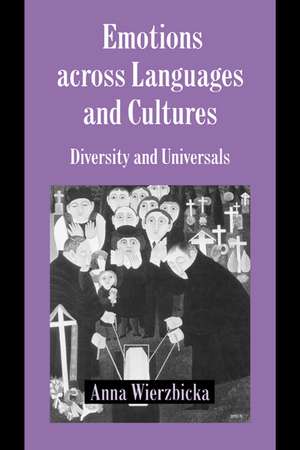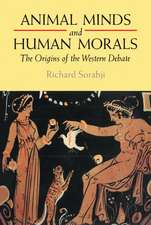Emotions across Languages and Cultures: Diversity and Universals: Studies in Emotion and Social Interaction
Autor Anna Wierzbickaen Limba Engleză Paperback – 17 noi 1999
| Toate formatele și edițiile | Preț | Express |
|---|---|---|
| Paperback (1) | 354.03 lei 6-8 săpt. | |
| Cambridge University Press – 17 noi 1999 | 354.03 lei 6-8 săpt. | |
| Hardback (1) | 785.17 lei 6-8 săpt. | |
| Cambridge University Press – 17 noi 1999 | 785.17 lei 6-8 săpt. |
Din seria Studies in Emotion and Social Interaction
-
 Preț: 177.14 lei
Preț: 177.14 lei -
 Preț: 154.69 lei
Preț: 154.69 lei -
 Preț: 201.48 lei
Preț: 201.48 lei - 14%
 Preț: 787.78 lei
Preț: 787.78 lei - 9%
 Preț: 694.81 lei
Preț: 694.81 lei -
 Preț: 323.18 lei
Preț: 323.18 lei -
 Preț: 397.46 lei
Preț: 397.46 lei -
 Preț: 322.62 lei
Preț: 322.62 lei -
 Preț: 353.02 lei
Preț: 353.02 lei -
 Preț: 287.87 lei
Preț: 287.87 lei -
 Preț: 449.38 lei
Preț: 449.38 lei -
 Preț: 360.39 lei
Preț: 360.39 lei -
 Preț: 327.68 lei
Preț: 327.68 lei - 11%
 Preț: 426.80 lei
Preț: 426.80 lei - 14%
 Preț: 729.08 lei
Preț: 729.08 lei - 11%
 Preț: 700.16 lei
Preț: 700.16 lei - 14%
 Preț: 727.26 lei
Preț: 727.26 lei - 14%
 Preț: 793.59 lei
Preț: 793.59 lei -
 Preț: 353.10 lei
Preț: 353.10 lei -
 Preț: 389.84 lei
Preț: 389.84 lei -
 Preț: 423.39 lei
Preț: 423.39 lei - 11%
 Preț: 528.82 lei
Preț: 528.82 lei -
 Preț: 361.92 lei
Preț: 361.92 lei -
 Preț: 327.20 lei
Preț: 327.20 lei - 14%
 Preț: 725.57 lei
Preț: 725.57 lei -
 Preț: 346.23 lei
Preț: 346.23 lei - 14%
 Preț: 898.82 lei
Preț: 898.82 lei - 14%
 Preț: 676.89 lei
Preț: 676.89 lei - 5%
 Preț: 357.54 lei
Preț: 357.54 lei - 14%
 Preț: 853.80 lei
Preț: 853.80 lei -
 Preț: 360.26 lei
Preț: 360.26 lei -
 Preț: 378.36 lei
Preț: 378.36 lei - 14%
 Preț: 726.23 lei
Preț: 726.23 lei -
 Preț: 364.42 lei
Preț: 364.42 lei - 11%
 Preț: 469.84 lei
Preț: 469.84 lei
Preț: 354.03 lei
Nou
Puncte Express: 531
Preț estimativ în valută:
67.76€ • 73.63$ • 56.96£
67.76€ • 73.63$ • 56.96£
Carte tipărită la comandă
Livrare economică 21 aprilie-05 mai
Preluare comenzi: 021 569.72.76
Specificații
ISBN-13: 9780521599719
ISBN-10: 0521599717
Pagini: 364
Ilustrații: 8 b/w illus.
Dimensiuni: 153 x 230 x 23 mm
Greutate: 0.54 kg
Editura: Cambridge University Press
Colecția Cambridge University Press
Seria Studies in Emotion and Social Interaction
Locul publicării:Cambridge, United Kingdom
ISBN-10: 0521599717
Pagini: 364
Ilustrații: 8 b/w illus.
Dimensiuni: 153 x 230 x 23 mm
Greutate: 0.54 kg
Editura: Cambridge University Press
Colecția Cambridge University Press
Seria Studies in Emotion and Social Interaction
Locul publicării:Cambridge, United Kingdom
Cuprins
Introduction; Part I. Feelings, Languages and Cultures: 1. Emotions or feelings?; 2. Breaking the 'hermeneutical circle'; 3. 'Experience-near' and 'experience-distant' concepts; 4. Describing feelings through prototypes; 5. 'Emotions': disruptive episodes or vital forces that mould our lives?; 6. Why words matter; 7. Emotion and culture; 8. The Natural Semantic Metalanguage (NSM) as a tool for cross-cultural analysis; 9. An illustration: 'sadness' in English and in Russian; 10. The scope of this book; Part II. Defining Emotion Concepts: Discovering 'Cognitive Scenarios': 1. 'Something good happened' and related concepts; 2. 'Something bad happened' and related concepts; 3. 'Bad things can happen' and related concepts; 4. 'I don't want things like this to happen' and related concepts; 5. Thinking about 'someone else'; 6. Thinking about ourselves; 7. Concluding remarks; Part III. A Case Study of Emotion in Culture: German 'Angst': 1. Angst as a peculiarly German concept; 2. Heidegger's analysis of angst; 3. Angst in the language of psychology; 4. Angst in everyday language; 5. Defining angst; 6. The German angst in a comparative perspective; 7. Luther's influence on the German language; 8. Eschatological anxieties of Luther's times; 9. The meaning of angst in Luther's writings; 10. Martin Luther's inner life and its possible impact on the history of angst; 11. Luther's possible role in the shift from angst 'affliction' to angst 'anxiety/fear'; 12. The great social and economic anxieties of Luther's times; 13. Uncertainty vs certainty, angst vs sicherheit; 14. Certainty and ordnung; 15. Conclusion; Part IV. Reading Human Faces: 1. The human face: a 'mirror' or a 'tool'; 2. From the 'psychology of facial expression' to the 'semantics of facial expression'; 3. 'Social' does not mean 'voluntary'; 4. What kind of 'messages' can a face transmit?; 5. Messages are not 'dimensions'; 6. 'The face alone' or 'the face in context'?; 7. Analyzing facial behaviour into meaningful components; 8. Summing up the assumptions; 9. In what terms should facial behaviour be described?; 10. Humans and primates: a unified framework for verbal, non-verbal, and preverbal communication; 11. The meaning of eyebrows drawn together; 12. The meaning of 'raised eyebrows'; 13. The meaning of the 'wide open eyes' (with immobile eyebrows); 14. The meaning of a turned down mouth; 15. The meaning of tightly pressed lips; 16. Conclusion: the what, the how, and the why in reading human faces; Part V. Russian Emotional Expression: 1. Introduction; 2. Emotion and the body; 3. Conclusion; Part VI. Comparing Emotional Norms across Languages and Cultures: Polish vs Anglo-American: 1. Emotion and culture; 2. The scripts of 'sincerity'; 3. The scripts of interpersonal 'warmth'; 4. The scripts of 'spontaneity'; 5. Conclusion; Part VII. Emotional Universals: 1. 'Emotional universals' - genuine and spurious; 2. A proposed set of 'emotional universals'; 3. Conclusion; Further reading; Index.
Descriere
This fascinating book explores the bodily expression of emotion in worldwide and culture-specific contexts.


















